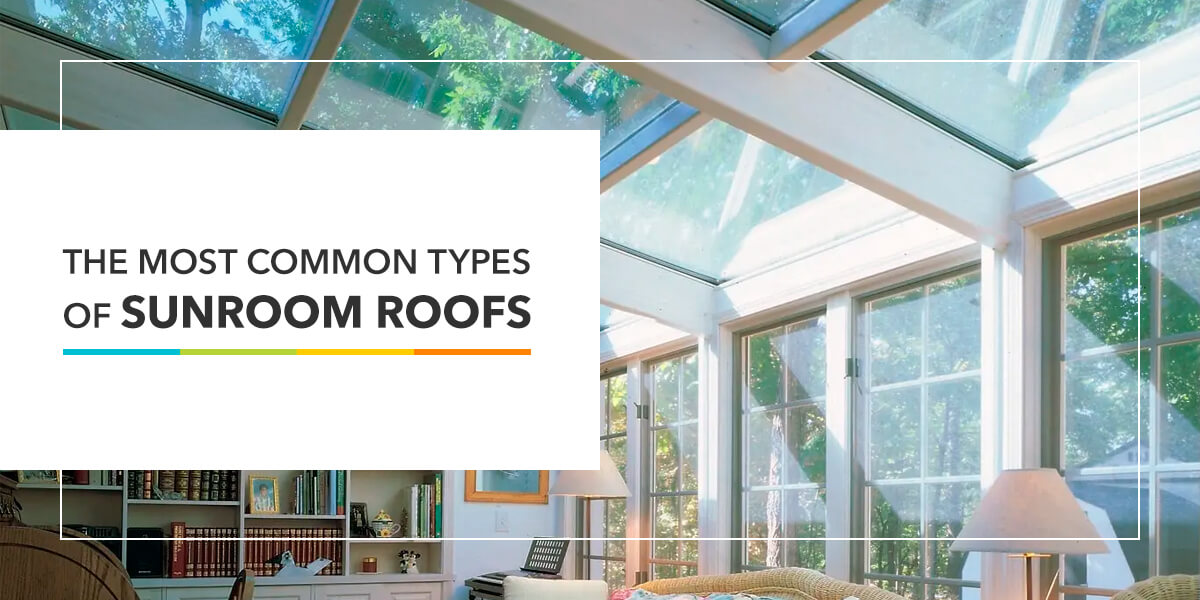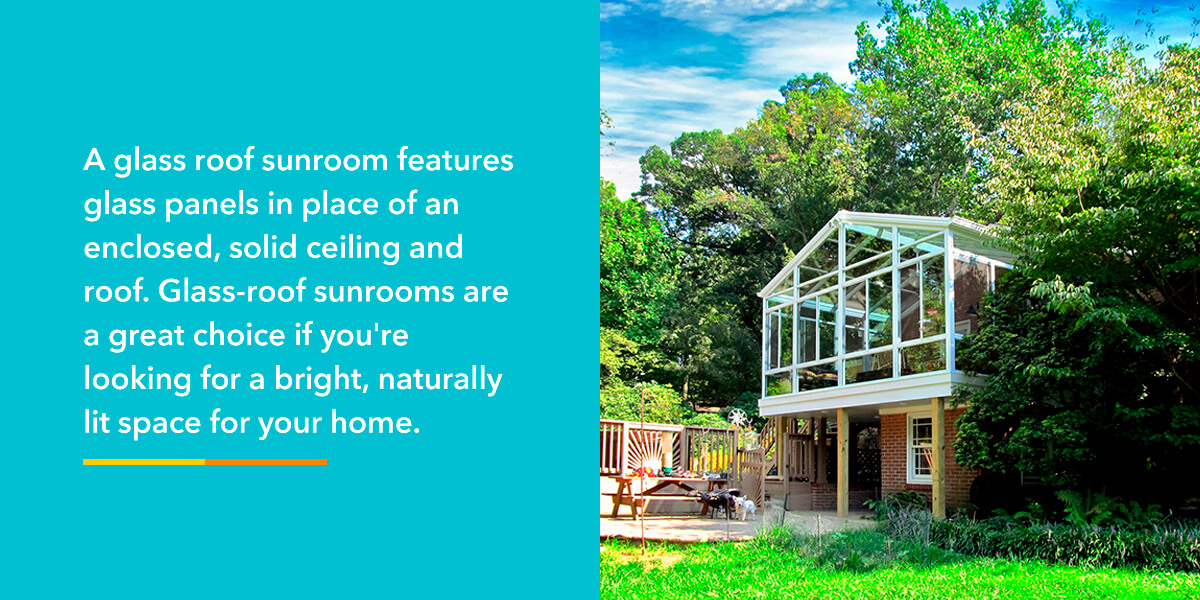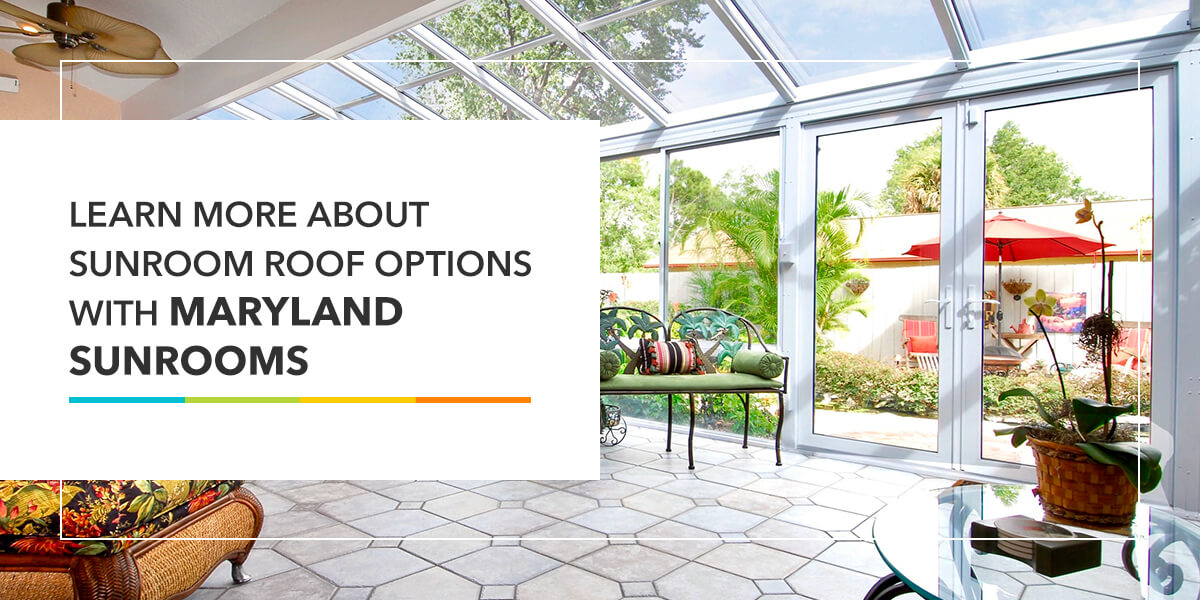You are taking the leap and adding a sunroom to your home, but have you considered the type of roof you want? Whether you’re adding a new sunroom or closing in an already existing patio, deck or porch to create a sunroom, considering the type of roof that best suits your home is an important step in the process.
There are several different types of sunroom roofs, each with its own set of pros and cons. With so many different options, styles and materials to choose from, designing your new sunroom’s roof can be overwhelming. If you’re having a hard time deciding which type of roof is best suited to meet your needs and match your home’s style, then here’s a helpful breakdown of the most common types of sunroom roofs.
Sunroom Roof Options
You have a lot of options when designing your new sunroom roof. You’ll want to consider a few different aspects including the slope, the style, and the material. The two most common types of slopes in sunrooms are gable and single-slope roofs.
Gable Roof vs Single-Slope Roof
A gable roof refers to a more traditional style roof that looks similar to an A-frame. A single-slope roof is the most common type of roof for home additions. Let’s take a closer look at some of the pros and cons associated with each.
What is a Gable-roof Sunroom?
A gable roof sunroom roof is characterized by two sloping sides that meet at a peak in the middle. Gable-roof sunrooms are designed at a 40-degree angle joined in the middle. There are several pros and cons associated with gable roof sunrooms.
- Pros of a gable-roof sunroom: Since the two sides of a gable-roof sunroom slope away from one another in opposite directions, it allows for water and other precipitation to easily run off. The vaulted ceilings of a gable roof sunroom provide lots of extra space and are easily designed to match your existing home.
- Cons of a gable-roof sunroom: Gable-roof sunrooms are difficult to construct on your own. The design of the two sloping sides of the roof requires professional planning and building. The hard slope of the gable-roof sunrooms is not ideal if you frequently experience high winds or intense storms, such as in coastal areas.
Learn More About Our Product Offerings
What is a Single-slope-roof Sunroom?
A single-slope-roof sunroom features a singular sloping roof such as those typically found on sheds. Single-slope-roof sunroom designs are common and have different pros and cons associated with them.
- Pros of a single-slope roof sunroom: A single-slope roof sunroom requires fewer materials and labor to construct. This makes single-slope roofs more affordable than other options. The simple design of single-slope roof sunrooms means they easily match your home’s existing style.
- Cons of a single-slope roof sunroom: A single-slope-roof sunroom doesn’t offer as much ceiling height as gable-roof designs. This also means less ventilation and not as many options for installing features such as lighting fixtures and decor.
Sunroom Roof Materials
The two most common types of sunroom roof materials are solid, such as shingles or aluminum, and glass. Deciding on the type of material that best fits your new sunroom is a matter of preference and lifestyle. You’ll want to design your sunroom roof to best suit your needs and match your home’s existing design elements.
Glass Roof vs Solid Roof
Deciding on a sunroom solid roof or sunroom glass roof requires you to consider things like your budget, timeline for building and lifestyle preferences. There are different styles of glass and solid sunroom roofs as well as several pros and cons that you need to consider before you get started building.
What is a Glass Roof Sunroom?
A glass roof sunroom features glass panels in place of an enclosed, solid ceiling and roof. Glass-roof sunrooms are a great choice if you’re looking for a bright, naturally lit space for your home.
- Pros of a glass roof sunroom: Glass-roof sunrooms provide you with plenty of natural light and connect you with the outdoors. If you’re looking for a space that offers views of your surrounding property, then a glass-roof sunroom is a great choice.
- Cons of a glass roof sunroom: Glass-roof sunrooms are beautiful and stunning to look at but will be more expensive and time-consuming to construct than a traditional solid-roof design. If your budget is a top concern, then you’ll also want to consider the cost associated with sunroom roof repair when choosing a glass roof. Broken, cracked or chipped glass panels are more expensive to replace or repair than traditional solid roofing materials.
Types of Glass Roofs
There are different types of glass roofs, each characterized by unique features and traits, including:
- Straight eave or studio glass roof: These are single-slope glass roofs that offer a seamless transition from your existing home to your new sunroom addition.
- Cathedral glass roof: These feature a front peaked wall that offers an extended view of the outdoors while maintaining a spacious, comfortable interior.
- Georgian glass roof: These feature high ceilings that allow natural light to enter from a variety of angles surrounding the structure.
- Victorian glass roof: These feature increased ceiling height and maximum window openings with a rounded bayfront inspired by the design of Renaissance castles.
- Curved eave glass roof: These feature a dramatic and elegantly curved eave front. Curved eave glass roofs complement your existing roofline and offer a clean look.
Learn More About Our Product Offerings
What is a Solid Roof Sunroom?
A solid roof sunroom provides you with a private, enclosed space and is typically constructed using shingles or aluminum roofing materials.
- Pros of a solid roof sunroom: Solid roof sunrooms are built to blend seamlessly with your home’s existing roof using the same types of materials, such as shingles or aluminum roof panels. Solid roof sunrooms offer increased privacy, protection from UV exposure and reduced heat from the sun.
- Cons of a solid roof sunroom: A solid roof sunroom is not the best choice if you’re looking to add a naturally lit space to your home. Solid roof sunrooms don’t allow for as much natural light or heat to enter the space as glass roofs.
Types of Solid Roofs
Just like glass roofs, there are different types of solid-roof sunrooms to consider, including:
- Straight eave or studio solid roof: These are characterized by a single-slope roof that transitions seamlessly from your home’s existing roof.
- Cathedral solid roof: This style is similar to straight eave roof with one or more flat panels capping off the top to provide high vaulted ceilings.
- Georgian solid roof: The three sloping sides of a Georgian roof style provide high ceilings and increased space.
- Victorian solid roof: The increased ceiling height is characteristic of Victorian solid roofs. The gable features of Victorian roofs provide extra space and ventilation for your sunroom.
- Curved eave solid roof: The clean, polished look of curved eave solid roofs make the transition from your existing home’s roof to your sunroom seamless and smooth.
Types of Hybrid Roofs
Are you looking for the perfect combination of style and function in your sunroom? If you desire a unique custom space, then consider a hybrid roof design. A hybrid roof combines features and styles from various sunroom roof concepts. For example, you can consider a solid roof design with elements of a glass roof incorporated, such as skylights or glass panels in certain places. This allows you the benefits of a glass roof without having to construct the entire roof with glass panels.
Choosing the Right Roof for You
Deciding which type of sunroom roof is right for you depends on several factors including:
- Budget: How much money are you willing to spend on your new sunroom roof? Consider what you’re willing to spend by evaluating the features you’re looking for in a new sunroom.
- Lifestyle and use: Consider the times of day and year you’ll be using your sunroom. Your sunroom roof should be designed to match your intended use of the space. Are you planning to entertain guests or host parties in the space? Are you sensitive to UV light or the heat from the sun? These are the sorts of questions to ask yourself when considering your sunroom roof.
- Exposure to sunlight: Consider your sensitivity to sunlight and heat from the sun when choosing the type of sunroom roof that’s right for you. If you’re looking for a bright space to enjoy the sunshine, then you’ll want to consider a glass-roof sunroom.
- Existing architecture and design: Take into account your existing home’s architecture and design when choosing your sunroom roof. Certain styles blend better with existing architecture than others, so look at your home’s design before choosing a sunroom roof.
Learn More About Sunroom Roof Options With Maryland Sunrooms
Maryland Sunrooms offers a wide range of different sunroom roof options. With over 100 years of combined experience, Maryland Sunrooms is the top choice for designing and installing your sunroom. We proudly specialize in three- and four-season sunrooms and sunroom roof design, repair and maintenance. We provide exceptional customer service focused on personalized sunroom solutions for your home or property.
Ready to learn more about our sunroom roof options?. Fill out our online contact form or give us a call at 301-829-1313 to speak with a member of our trusted team and get started on your new sunroom design today!

Julie Shetter is the Marketing Director at Maryland Sunrooms. She has over a decade of experience in the home improvement and sunroom industry.




